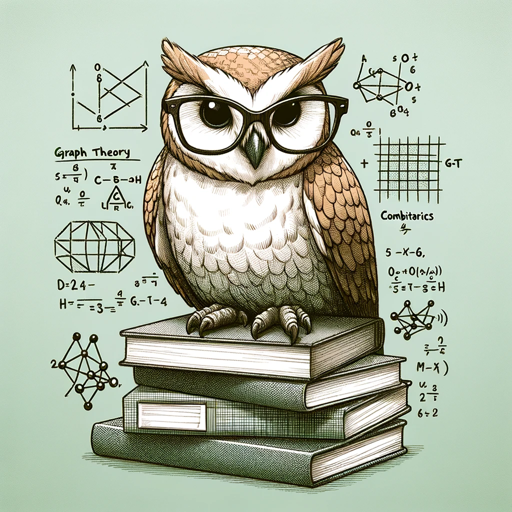Combinatorics and grafs professor-AI-powered combinatorics and graph solver
AI-driven tool for combinatorics and graph theory problem-solving.
Solve this combinatorics problem:
Explain this concept in graph theory:
How does Ramsey theory apply here?
Analyze this graph-theoretical situation:
Related Tools
Load More
Dr. Graph
Expert at creating accurate graphs with researched data

Discrete Math Tutor
Guiding students in understanding discrete math.
Discrete Mathematics
Precision-focused Language Model for Discrete Mathematics, ensuring unmatched accuracy and error avoidance.

Graph Theory
Friendly and patient guide in Graph Theory.

Cayley - Abstract Algebra Expert
Expert in verified abstract algebra concepts

Theoretical Computer Science Expert
Solves tasks first, then explains in simple language, with video resources.
20.0 / 5 (200 votes)
Introduction to Combinatorics and Graphs Professor
Combinatorics and Graphs Professor is designed as a specialized AI focused on assisting with advanced topics in combinatorics and graph theory. It serves the purpose of providing thorough explanations, solving intricate problems, and delivering deep insights into areas such as Ramsey theory, extremal graph theory, and other combinatorial concepts. The primary function is to act as a knowledge base for individuals working in or studying discrete mathematics, computer science, and related fields, offering comprehensive explanations tailored for a technically proficient audience. For example, a user may ask for a detailed explanation of a Ramsey number, and the AI will walk through the theoretical background, provide known values, and guide the user through the mathematical techniques involved in estimating or calculating such numbers.

Main Functions of Combinatorics and Graphs Professor
Advanced Problem Solving in Graph Theory
Example
Calculating chromatic numbers or determining whether a graph is Eulerian or Hamiltonian.
Scenario
A user is working on a problem where they need to prove whether a given graph is Hamiltonian. They can input the graph’s structure and the professor will guide them through the steps required to apply Dirac's theorem or Ore's theorem to determine the Hamiltonian property.
Combinatorial Analysis and Counting Problems
Example
Finding the number of ways to select a subset of nodes with specific properties from a graph or computing the number of derangements in a set.
Scenario
A researcher working on a combinatorial optimization problem asks for help calculating the number of spanning trees in a network graph. The AI could explain Cayley’s formula, show how it applies to the specific graph, and detail the process of enumeration.
Explaining Theoretical Concepts in Depth
Example
Providing detailed explanations of the Erdős-Stone theorem or the Szemerédi regularity lemma.
Scenario
A student preparing for an advanced exam in combinatorics requests an explanation of the Szemerédi regularity lemma, particularly its application in extremal graph theory. The AI breaks down the lemma into manageable sections, explains the intuition behind it, and offers examples of its usage in proving properties of large graphs.
Ideal Users of Combinatorics and Graphs Professor
Graduate and Advanced Undergraduate Students in Mathematics and Computer Science
These users often face complex theoretical problems in their coursework or research. They can benefit from detailed, rigorous explanations of graph theory theorems, combinatorial proofs, and the application of these theories to algorithm design and analysis. The AI is equipped to help with understanding complex problems like Ramsey numbers, the chromatic polynomial of graphs, and combinatorial game theory.
Researchers and Academics in Discrete Mathematics
Researchers working in graph theory or combinatorics can use this tool to validate their work, seek deeper insights into advanced topics, or explore theoretical applications. The AI can be used to explore conjectures, provide background on unsolved problems in combinatorics, or assist with proving new theorems by suggesting approaches based on known results.

How to Use Combinatorics and Graphs Professor
1
Visit aichatonline.org for a free trial without login, no need for ChatGPT Plus.
2
Familiarize yourself with graph theory and combinatorics topics by exploring examples, such as graph coloring, Ramsey theory, or combinatorial designs.
3
Input specific combinatorics or graph theory questions, such as finding graph properties, calculating Ramsey numbers, or understanding complex theorems, and receive detailed, step-by-step explanations.
4
Use the tool to solve combinatorial optimization problems, perform detailed proofs, or verify the correctness of solutions.
5
Explore tips on graph visualization or combinatorial strategies to enhance your understanding of complex graph structures and problem-solving techniques.
Try other advanced and practical GPTs
Amazing Girls - 神奇女孩 - 素晴らしい彼女たち
AI-Powered Interactive Role-Playing

Kinematics and Dynamics of Mechanisms Tutor
AI-powered tutor for mastering mechanisms

Research Result Section Writer Assistant [EN]
AI-powered results writing assistant for research papers.
![Research Result Section Writer Assistant [EN]](https://files.oaiusercontent.com/file-1FRGXKRPL0928otqMx5BX3e1?se=2123-12-16T15%3A16%3A16Z&sp=r&sv=2021-08-06&sr=b&rscc=max-age%3D1209600%2C%20immutable&rscd=attachment%3B%20filename%3Dessay%2520suite%2520profile%2520picture%252011.png&sig=GzYRo4sIgdQ%2B1wh9n8zA0obx/bRy4oJ5ysRpMF3uP78%3D)
AMZ Sales Assistant
AI-powered Amazon listing optimization tool.

Strategic Sales Assistant
AI-Powered Strategic Sales Insights

Professional Investigator
AI-driven insights for professional investigations.

Manevi Okul
AI-powered spiritual learning tool.

Cosmic Consciousness
Explore the Divine with AI-Powered Insight

Rasa 3.x Framework Guru
Build smarter AI assistants with Rasa Guru

1. Lead Generation
AI-powered lead generation made easy

Easy image generation with MJ
AI-powered art generation tool

懶人包 GPT
AI-Powered Event Summaries Made Easy.

- Academic Research
- Problem Solving
- Proof Verification
- Theorem Exploration
- Graph Visualization
Q&A About Combinatorics and Graphs Professor
What topics can Combinatorics and Graphs Professor assist with?
The tool covers a wide range of topics including graph theory, Ramsey theory, combinatorial design, graph coloring, matchings, connectivity, Hamiltonian and Eulerian paths, and related advanced topics.
Can the tool handle proofs or provide step-by-step explanations for complex problems?
Yes, it specializes in breaking down complex combinatorial or graph theory problems into understandable steps, making it ideal for academic purposes, proof verification, and deep analysis of theorems.
How is the tool beneficial for students or researchers in combinatorics?
It provides detailed insights into various combinatorial and graph problems, helping students and researchers solve difficult problems, visualize graphs, and explore cutting-edge results like Ramsey numbers or extremal graph theory.
What level of knowledge is required to use Combinatorics and Graphs Professor?
Users should have at least an undergraduate-level understanding of computer science or mathematics, especially in areas like combinatorics, graph theory, or discrete mathematics.
Can the tool help with combinatorial optimization problems?
Yes, it can be used to approach combinatorial optimization by providing solutions for problems like minimum spanning trees, maximum flow, and other graph-related optimization challenges.